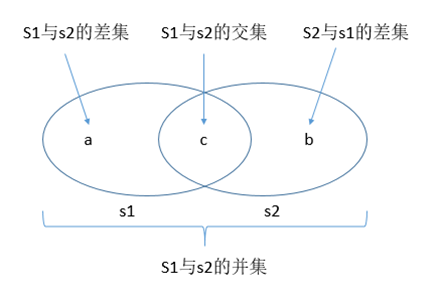python(3)-集合
2016-02-24 22:46
696 查看
集合就是把不同的元素组织在一起,但在集合中不允许有重复的元素。
集合中不允许出现重复的元素
集合的访问:
因为集合是无序的,所以不能对它进行切片,只能遍历,in 或 not in 等方法
向集合添加元素,删除元素
清空集合元素及删除集合
下面重温一下并集,交集,差集的概念

差集,difference() 返回一个新集合
交集,& 或 intersection() 返回一个新集合
并集, | 或 union() 返回一个新集合
集合是不能相加,但可以相减
集合之间的and , or
difference_update() 传什么进来就删除什么
intersection_update() 还是看例子吧,好理解
pop() 在集合中随机删除一个元素并返回该元素,此方法不能带参数
s1.symmetric_difference(s2) #取出两边的差集
最觉的应用,便是去除重复的元素
>>> a = set() #创建集合 >>> type(a) <class 'set'>
集合中不允许出现重复的元素
>>> a.add('jack') #向集合中添加元素
>>> print(a)
{'jack'}
>>> a.add("jack") #再次向集合中添加同样的元素
>>> print(a)
{'jack'} #同样的元素只能出现一次集合的访问:
因为集合是无序的,所以不能对它进行切片,只能遍历,in 或 not in 等方法
>>> s = set("fjihutiejhgir")
>>> print(s)
{'u', 'h', 'i', 'e', 'g', 'j', 't', 'r', 'f'}
>>> a in s
False
>>> a not in s
True
>>> for i in s:
... print(i)
...
u
h
i
e
g
j
t
r
f
>>>向集合添加元素,删除元素
>>> s = set("a")
>>> s.update("b") #添加元素
>>> print(s)
{'b', 'a'}
>>> s.add("c") #添加元素
>>> print(s)
{'b', 'a', 'c'}
>>> s.remove("a") #删除元素
>>> print(s)
{'b', 'c'}
>>>清空集合元素及删除集合
>>> s.clear() >>> print(s) set() >>> del s >>> print(s) Traceback (most recent call last): File "<stdin>", line 1, in <module> NameError: name 's' is not defined
下面重温一下并集,交集,差集的概念

差集,difference() 返回一个新集合
>>> s1 = set("abcdefg")
>>> s2 = set("efghijk")
>>> s1.difference(s2) #s1与s2的差集
{'b', 'a', 'd', 'c'}
>>> s2.difference(s1) #s2与s1的差集
{'j', 'h', 'i', 'k'}交集,& 或 intersection() 返回一个新集合
>>> s1&s2
{'g', 'f', 'e'}
>>> s3 = s1&s2
>>> print(s3)
{'g', 'f', 'e'}
>>> s4 = s1.intersection(s2)
>>> print(s4)
{'g', 'f', 'e'}
>>>并集, | 或 union() 返回一个新集合
>>> s3 = s1|s2
>>> print(s3)
{'h', 'a', 'd', 'e', 'i', 'k', 'g', 'b', 'j', 'f', 'c'}
>>> s4 = s1.union(s2)
>>> print(s4)
{'h', 'a', 'd', 'e', 'i', 'k', 'g', 'b', 'j', 'f', 'c'}集合是不能相加,但可以相减
>>> s1-s2
{'b', 'a', 'd', 'c'}
>>> s3 = s1+s2
Traceback (most recent call last):
File "<stdin>", line 1, in <module>
TypeError: unsupported operand type(s) for +: 'set' and 'set'集合之间的and , or
>>> s1 = set("abc")
>>> s2 = set("cde")
>>> s1 and s2 #取s2
{'c', 'd', 'e'}
>>> s1 or s2 #取s1
{'b', 'a', 'c'}difference_update() 传什么进来就删除什么
>>> s1 = set("abcdefg")
>>> s1.difference_update("a")
>>> print(s1)
{'d', 'e', 'g', 'b', 'f', 'c'}intersection_update() 还是看例子吧,好理解
>>> s1 = set("abcdefg")
>>> s2 = set("efghij")
>>> s1.intersection_update(s2) #在s1中只保留s1和s2中都有的元素
>>> print(s1)
{'g', 'f', 'e'}pop() 在集合中随机删除一个元素并返回该元素,此方法不能带参数
>>> s1.pop("a")
Traceback (most recent call last):
File "<stdin>", line 1, in <module>
TypeError: pop() takes no arguments (1 given)
>>> s1.pop()
'a'
>>> s1.pop()
'd's1.symmetric_difference(s2) #取出两边的差集
>>> s1 = set("abcdefg")
>>> s2 = set("efghij")
>>> s1.symmetric_difference(s2)
{'j', 'h', 'b', 'a', 'd', 'c', 'i'}最觉的应用,便是去除重复的元素
>>> li = [1,1,2,2,3,3,4,4,5,5,6,6]
>>> print(set(li))
{1, 2, 3, 4, 5, 6}
相关文章推荐
- python中BeautifulSoup模块的安装
- python基础学习九:类基础
- 第一个python的小程序
- 利用python进行数据分析笔记
- Python在Windows系统下安装环境的搭建
- python学习之11 加密解密hashlib
- 【Mastering Machine Learning with scikit-learn (python+spark版)】Chapter2 Linear Regression
- Win7下安装Python图像处理库PIL、pytesser、tesseract进行验证码识别
- python中requests的用法
- [LeetCode]题解(python):097-Interleaving String
- python模块系列之 - configparser
- Python扩展内置类型
- 一张图让你懂Python安装第三方库
- python解析xml配置文件
- [LeetCode]题解(python):096-Unique Binary Search Trees
- 《python核心编程》读书笔记--第18章 多线程编程
- Python 正则表达式(模式匹配)
- [LeetCode]题解(python):095-Unique Binary Search Trees II
- python学习之10 随机数random
- 平台后端开发(Python)面试记录
